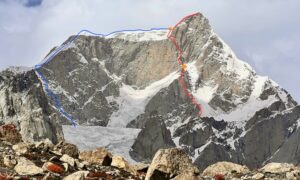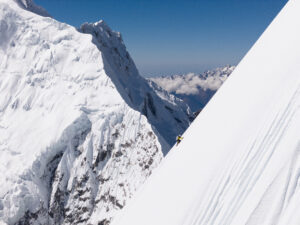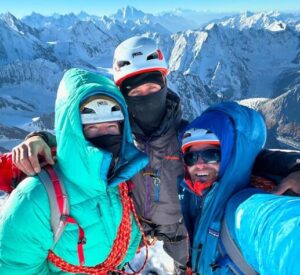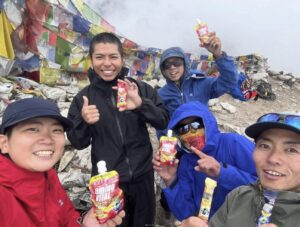Dane Steadman and Cody Winckler, who will receive a Piolet d’Or for the first ascent of Yashkuk Sar with August Franzen, now have two new Pakistan routes under their belts.
The pair went with Blake Berghoff to the remote northern ranges of Pakistan, aiming for unclimbed Dansam Peak, also known as K13.
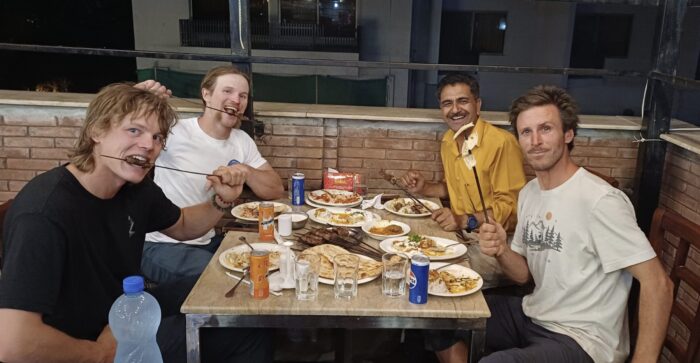
Left to right, Blake Berghoff, Dane Steadman, expedition operator Ali Saltoro, and Cody Winckler. Photo: Dane Steadman
Photos and reality
Authorities had kept Dansam closed to climbing for years, but the American team got a permit for this fall season. Steadman has dreamed of a line up the Dansam’s north buttress since he saw it in a picture in 2021. Sadly, it remains a dream because the climbers never managed to set foot on the route.
From Islamabad, the trio traveled to the remote village of Khorkondo, then trekked to base camp. They only caught glimpses of a magnificent peak in less than magnificent conditions.
“The central buttress, the only line clearly safe from the walls’ many seracs, looked terrible,” Steadman wrote. “What had looked like perfect granite in photos was actually decomposing munge, with abundant fresh scarring and lacking natural features, aside from fragile-looking flakes.”
That route was extremely difficult and maybe even impossible to descend. And traversing into Tibet without a visa would not have been a good idea.
Looking around, they considered an alternative route on icier slopes, but the threat of falling seracs put them off. After much thought, Steadman decided that the ascent, “no matter how significant it would be, was not worth dying for.”
Plan B
But as Ali Saltoro of Adventure Guides Pakistan told ExplorersWeb, there are plenty of routes on granite spires to open in that area.
“Up a side valley from the main Ming Ling Glacier, a striking fang of granite rose out of a ridge, the biggest tooth in the jawbone, and demanded attention. We’d never heard of it before, and according to our topo maps, it didn’t even exist, but after a recon hike, we knew we had an objective,” Steadman said.

Dawn at a bivouac. Photo: Dane Steadman
The climbers cached big wall gear at the base of the tower and set off on September 21.
Steadman described 500 vertical meters of granite climber’s paradise.
“We found ice-filled chimneys, ice tool/rock shoe combo climbing, funky aid climbing, steep sunny crack climbing, and strange swirly face climbing,” he recalls.
The team reached the top of the tooth, with their GPS marking 6,082m, at sunset on September 23. The team estimates the route was 5.10 A2+ AI4 M6.
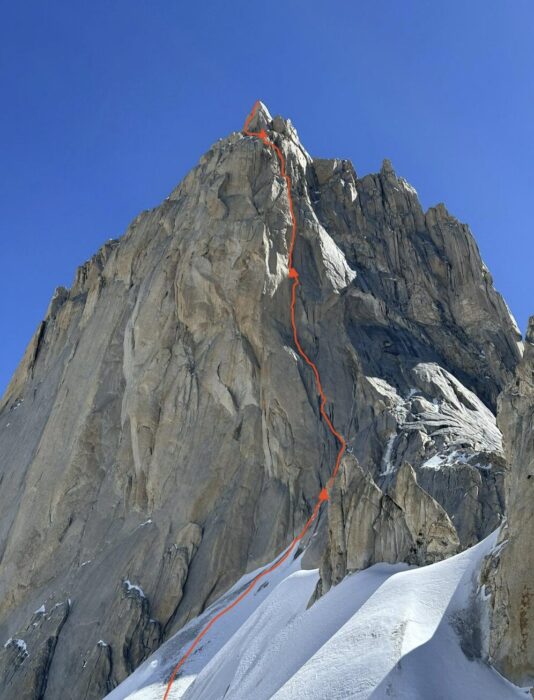
The route topo. Photo: Dane Steadman
Still hungry
The rock climb was good, but they were hungry for more. They had come to the remote areas of Pakistan to climb “an aesthetic, objectively safe, technically demanding, and exploratory climb on a big, cold mountain,” as Steadman put it.
With K13 out of the question, the climbers considered an unclimbed, unnamed 6,300m peak at the head of the valley with a stunning north buttress.
The problem was the base was guarded by a shattered, almost impassable-looking icefall. Upon inspection of our satellite maps, the way became apparent: Hiking up a different, smoother branch of the Ming Ling Glacier would lead us to an icy col, across which lay a gap between icefalls that looked to lead directly to our buttress.

Mixed terrain on the unnamed peak. Photo: Dane Steadman
With six days of good weather left, the climbers set off on September 29. Blake Berghoff had numb toes since the Alaska season and decided to stay behind, while Cody Winckler and Dane Steadman crossed the icy col and a mellow stretch of the glacier to the base of the buttress.
Mixed terrain
The climb started with a rock band that required dry-tooling to reach their first bivouac.
“The second rock band was guarded by one of the more tenuous slab pitches I’ve climbed in crampons, and from there, surprisingly pleasant neve streaks brought us to the second ice band,” Steadman recalled.
“A painfully long traverse across ribs of glacial ice covered by sugary snow led to the great ice chimney that split the final rock band, just right of the steep face of the small serac that perched atop the buttress crest,” he added.
The second day ended with steep ice pitches in already dim light. Winckler and Steadman were lucky to find a good bivy spot at the right moment.

A surprisingly comfortable bivy spot during the climb. Photo: Dane Steadman
Our third day began with more steep ice after traversing back into the chimney, then eased off after we climbed up the low-angled side of the serac; from there, a long ice arete led to the summit glacier, where we pitched our tent before climbing up the final glaciated slopes to the knife-edged summit.
The climbers stood on the summit and returned to their tent at sunset. On the following morning, they rappelled down the buttress and walked back to the col and the end of the glacier, where Bergloff was waiting for them. It was the end of the climb and the good weather, as snow arrived the following day and didn’t stop for a week.
“The final route we climbed was around 1,450m tall and was likely the first ascent of the second major peak northeast of Dansam, which we measured at 6,310m. We encountered difficulties of M7 and AI4+, with a single move of C1.”

The new route on the unnamed peak. Photo/Topo: Dane Steadman


